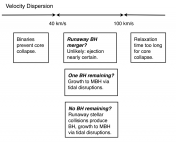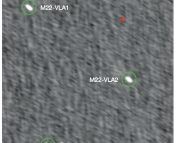Paper: A New Type of Compact Stellar Population: Dark Star Clusters
Authors: Sambaran Banerjee, Pavel Kroupa
First Author’s Institution: University of Bonn
(Observational) Astronomers study light, but as it turns out, not all objects that we are interested in are observable in any part of the electromagnetic spectrum. In cases such as these, we have to turn to indirect detection methods. This is perhaps most familiar to us from exoplanets. Most planets are so much dimmer than their host stars that they cannot be detected directly. Rather, they are detected indirectly. (There are, however, some exciting exceptions to this rule). In this work, however, the authors aren’t interested in exoplanets, but “dark star clusters.” These clusters would consist primarily of black holes, but maybe some neutron stars as well. Because neither of these objects emits light (in general), we would need to detect these clusters indirectly. In this work, the authors use N-Body simulations to predict how these clusters could possibly be “observed.”
These dark star clusters would originate from the centers of globular clusters, but they would be hard to find in a normal globular cluster. This is because the centers of globular clusters are extremely bright — so bright that it is hard to estimate the amount of luminous (and hence dark) mass there! While the formation of globular clusters is poorly understood, the dynamics have been studied in detail. So before going further, we need some background on the basic dynamics of globular clusters. Relatively small (in Galactic terms at least), globular clusters are stellar systems that are tightly gravitationally bound. Because the system is high density, the stars gravitationally “collide.” This doesn’t mean the stars actually collide, but that they approach close enough to have a gravitational encounter. This is called two-body relaxation. When two stars interact, some transfer of energy takes place. While in principle either star can transfer energy to the other, that isn’t what happens in practice. Because these interactions tend toward equipartition of kinetic energy, the star with more energy is more likely to transfer energy to the star with less energy, just as in thermodynamics. Let’s consider this in terms of two stars with masses m1and m2, where m1 > m2. The kinetic energy of the first star is 1/2m1v2; similarly, the kinetic energy of the second star is 1/2m2v2. If the stars are gravitationally interacting, they must be close to each other in the cluster, and so have comparable velocities because they are both subject to the same centripetal acceleration. That means the difference in kinetic energies of the two stars is dependent on mass. As a result, we expect the more massive star (m1) to transfer energy to the less massive star (m2). After the interaction, the less massive star (m2) has a higher velocity and can travel more distance outward in the gravitational potential of the cluster, whereas the higher mass star (m1) sinks inwards in the cluster. This dynamical friction causes more massive stars to tend towards the center of the cluster over time. This is called mass segregation.

An HST image of the globular cluster M15.
BUT, we haven’t accounted for the fact that stellar evolution was happening while all this mass segregation was going on. The stellar populations in globular clusters are uniform in age (typically about 10 Gyr) and obey a normal initial mass function. Given these properties, we expect that all the most massive stars in the cluster will have evolved to be black holes and neutron stars, which are more massive than the remaining (luminous) stars. This means that the center of our cluster should be dominated by this dark mass. Now we want to show this using our general knowledge of gravity, and the orbits of stars we can see in the globular cluster. In principle, we can use the orbits of stars to constrain a lot of mass to an area where we don’t see any emission. It’s been done very successfully in the Galactic Center, where orbits of stars have uncovered a supermassive black hole 4 million times the mass of our sun. So what’s the problem with globular clusters? Well, check out the picture of M15. The centers of globular clusters are so bright that it’s difficult to know how much luminous mass is present there, and thus difficult to figure out how much dark mass is there.
The authors of this paper suggest a new way to detect these clusters of compact remnants. They suggest that we should look at globular clusters in a strong tidal field. The setup is as follows: a globular cluster passes close to the center of our Galaxy. When it does so, objects are stripped from the cluster because of the strong gravity of the Galaxy. We know that this occurs, because we observe some tidal streams from previous interactions like this. When this tidal stripping happens, the authors note that luminous objects will get stripped from the globular cluster first, since they are typically lower mass than compact remnants and more likely to be in the outer edges of the cluster. They even suggest that the object IRS 13E, a cluster where about 10 luminous young stars were found tightly bound to an unseen mass, contains a cluster of black holes. (Another suggestion was intermediate mass black hole, but the work of Fritz et al. 2010 seems to rule this out). However, there is a potential problem with this scenario . . . a cluster of black holes will self deplete in a few Gyrs due to dynamical encounters which eject black holes from the cluster entirely (Banerjee et al. 2010).
So the question is, does the dark star cluster self-deplete before or after the tidal stripping of the globular cluster? The authors of this paper address this question using N-Body models. They model a globular cluster which is dynamically relaxed (i.e. the black holes are at the center) and that passes within 2 kiloparsecs of the Galactic Center. The models indicate that, in the case of a close encounter such as this, the outer stars would be stripped before the dark star cluster self-depletes. Furthermore, the authors estimate the likely Galactic population of dark star clusters, suggesting that a significant number of dark star clusters can be expected in the inner Galaxy.
Finding a dark cluster, if they exist, would be important for a variety of reasons. First, the mere existence of such a cluster would provide an important constraint for the kicks of core collapse supernovae. When core collapse supernova occur, there is a kick caused by either asymmetries in core collapse or because the explosion itself imparts a velocity to the remnant (see Nathan’s post for more details). If that velocity is very high, compact remnants will have high enough birth velocities that they do not remain in the globular cluster. This means that if dark star clusters exist, supernova kicks must be low enough, at least some of the time, such that supernova remnants remain bound to their clusters. Secondly, if we did find dark stellar clusters, they would be prime candidates for gravitational wave emission. The increased probability of the inspiral of black holes/neutron stars would make dark star clusters an ideal location for observations by Advanced LIGO and other gravitational wave detectors. Lastly, dark star clusters would be good candidates for black hole x-ray sources due to encounters with surrounding stars.





For what it’s worth, the paper was picked up in New Scientist. I might ask Sverre what he thinks at today’s group meeting…